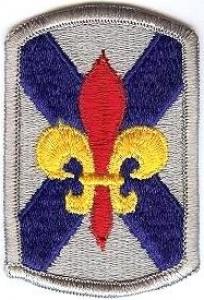全世界軍事百科事典
> アメリカ合衆国
> Shoulder Sleeve Insignia
> US Army Shoulder Patches
> Infantry
> US-INPTUS-00125

256 Infantry Brigade Patch. US Army
ランダム

Marine Corps Breast Patch of Naval Forces of Ukraine
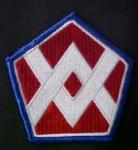
55 Sustainment Brigade Patch. US Army

Belarussian Desert Camo Uniform DCU pattern
情報を変える
Description
On a gray rectangular shield with arced top and bottom within a 1/8 inch (.32 cm) gray border 3 inches (7.62 cm) in height and 2 inches (5.08 cm) in width overall, a blue saltire surmounted by a fleur-de-lis the center frond red and the outer fronds and cross-bar gold.
Symbolism
The saltire, symbol used on military maps to represent a brigade, stands for the Organization. In addition, the saltire, which appears on the coat of arms of Nova Scotia and on the Confederate flag, alludes to the Brigade’s home area whose early inhabitants were from Nova Scotia, and to the Confederacy of which Louisiana was a part. The fleur-de-lis, referring to the location of the Brigade’s headquarters at Lafayette, stands for the French background and traditions of that part of the State. The center frond is red in reference to Lafayette’s original name, Vermilionville, and to nearby Bayou Vermilion. The combination of blue, for Infantry and gray, for the Confederacy, with red and gold also alludes to the branch colors for Artillery and various other components of the Brigade. The rectangle shield shape is the traditional shape for shoulder sleeve insignia of brigades.
Background
The shoulder sleeve insignia was originally approved for the 256th Infantry Brigade on 23 July 1968. It was redesignated for the 256th Infantry Brigade Combat Team and amended to update the description on 3 August 2007. (TIOH Drawing Number A-1-500)
On a gray rectangular shield with arced top and bottom within a 1/8 inch (.32 cm) gray border 3 inches (7.62 cm) in height and 2 inches (5.08 cm) in width overall, a blue saltire surmounted by a fleur-de-lis the center frond red and the outer fronds and cross-bar gold.
Symbolism
The saltire, symbol used on military maps to represent a brigade, stands for the Organization. In addition, the saltire, which appears on the coat of arms of Nova Scotia and on the Confederate flag, alludes to the Brigade’s home area whose early inhabitants were from Nova Scotia, and to the Confederacy of which Louisiana was a part. The fleur-de-lis, referring to the location of the Brigade’s headquarters at Lafayette, stands for the French background and traditions of that part of the State. The center frond is red in reference to Lafayette’s original name, Vermilionville, and to nearby Bayou Vermilion. The combination of blue, for Infantry and gray, for the Confederacy, with red and gold also alludes to the branch colors for Artillery and various other components of the Brigade. The rectangle shield shape is the traditional shape for shoulder sleeve insignia of brigades.
Background
The shoulder sleeve insignia was originally approved for the 256th Infantry Brigade on 23 July 1968. It was redesignated for the 256th Infantry Brigade Combat Team and amended to update the description on 3 August 2007. (TIOH Drawing Number A-1-500)
もう一度カテゴリーから: Infantry
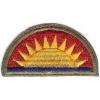 41 Infantry Brigade Combat Team Patch. US Army
41 Infantry Brigade Combat Team Patch. US Army
 84 Infantry Division (Training) Patch. US Army
84 Infantry Division (Training) Patch. US Army
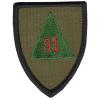 91 Training Division Patch. US Army
91 Training Division Patch. US Army
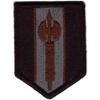 302 Maneuver Enhancement Brigade Patch. US Army
302 Maneuver Enhancement Brigade Patch. US Army
 3d Ranger Battalion Shoulder Sleeve Insignia. US Army
3d Ranger Battalion Shoulder Sleeve Insignia. US Army

